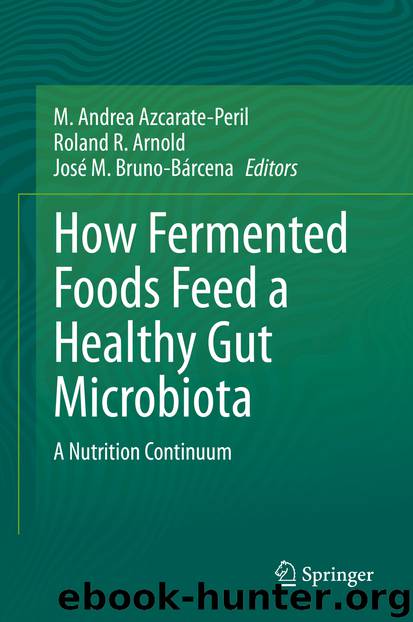How Fermented Foods Feed a Healthy Gut Microbiota by M. Andrea Azcarate-Peril & Roland R. Arnold & José M. Bruno-Bárcena

Author:M. Andrea Azcarate-Peril & Roland R. Arnold & José M. Bruno-Bárcena
Language: eng
Format: epub
ISBN: 9783030287375
Publisher: Springer International Publishing
Periodontal Diseases: Gingivitis and Periodontitis
As discussed previously, the biofilm that accumulates on the tooth surface exposed to the oral cavity (supragingival plaque) is saliva-bathed, composed mainly of saccharolytic, acidogenic and aciduric populations of bacteria selected by dietary sugar on nutrient poor enamel surfaces of the teeth. In contrast, there are unique ecological niches created by the architecture and dynamics of the supporting structures of the teeth that select for asaccharolytic, nutritionally fastidious, acid-intolerant, proteolytic anaerobes.
The attachment of epithelium to teeth in a healthy dentition occurs at the transition from the enamel surfaces of the crown of the tooth to the cementum of the root (cemento-enamel junction ) forming a thin barrier (junctional epithelium) that protects the underlying supporting structures. The teeth are suspended in sockets in the alveolar bone of the jaws by periodontal ligament. The gingiva (gums) create a sulcus (gingival crevice) surrounding teeth that is composed of unique specialized gingival epithelial cells and keratinocytes. This arrangement creates a close association between the non-sloughing hard surfaces of the teeth and the renewable soft tissue of the gingiva that limits accessibility of saliva and provides microbial attachment sites on both mineral and cell surfaces bathed in a protein rich, tissue-derived gingival crevicular fluid (GCF ) of this subgingival space. This relatively sequestered site if undisturbed permits a hierarchical development of complex biofilm communities driven by environmental alterations in nutrient availability, oxygen limitations, specific interspecies co-aggregations, synergisms and antagonisms.
As with the supragingival plaque, the early subgingival colonizers are predominated by facultative anaerobes including the saccharolytic streptococci and actinomycetes. If the biofilm is permitted to develop without mechanical disruption (oral hygiene), robust bacterial species such as Fusobacteria and Prevotella (Ramberg et al. 2003) neutralize the pH of this subgingival environment by nitrogenous metabolism and stimulate increased efflux of GCF further promoting proteolytic activity allowing a shift in the microbial communities toward the establishment of more acid-intolerant, oxygen-sensitive, more diverse, inflammation-promoting and potentially periodontopathic species.
Download
This site does not store any files on its server. We only index and link to content provided by other sites. Please contact the content providers to delete copyright contents if any and email us, we'll remove relevant links or contents immediately.
Craft Beer for the Homebrewer by Michael Agnew(18082)
Marijuana Grower's Handbook by Ed Rosenthal(3584)
Barkskins by Annie Proulx(3254)
Project Animal Farm: An Accidental Journey into the Secret World of Farming and the Truth About Our Food by Sonia Faruqi(3139)
Red Famine: Stalin's War on Ukraine by Anne Applebaum(2847)
The Plant Messiah by Carlos Magdalena(2839)
0041152001443424520 .pdf by Unknown(2727)
Organic Mushroom Farming and Mycoremediation by Tradd Cotter(2602)
In the Woods by Tana French(2496)
Beer is proof God loves us by Charles W. Bamforth(2342)
7-14 Days by Noah Waters(2290)
Reservoir 13 by Jon McGregor(2213)
The Art of Making Gelato by Morgan Morano(2190)
Meathooked by Marta Zaraska(2174)
Birds, Beasts and Relatives by Gerald Durrell(2156)
Borders by unknow(2143)
Between Two Fires by Christopher Buehlman(2111)
The 7 Habits of Highly Effective People: Powerful Lessons in Personal Change (25th Anniversary Edition) by Covey Stephen R(2108)
The Lean Farm Guide to Growing Vegetables: More In-Depth Lean Techniques for Efficient Organic Production by Ben Hartman(2046)
